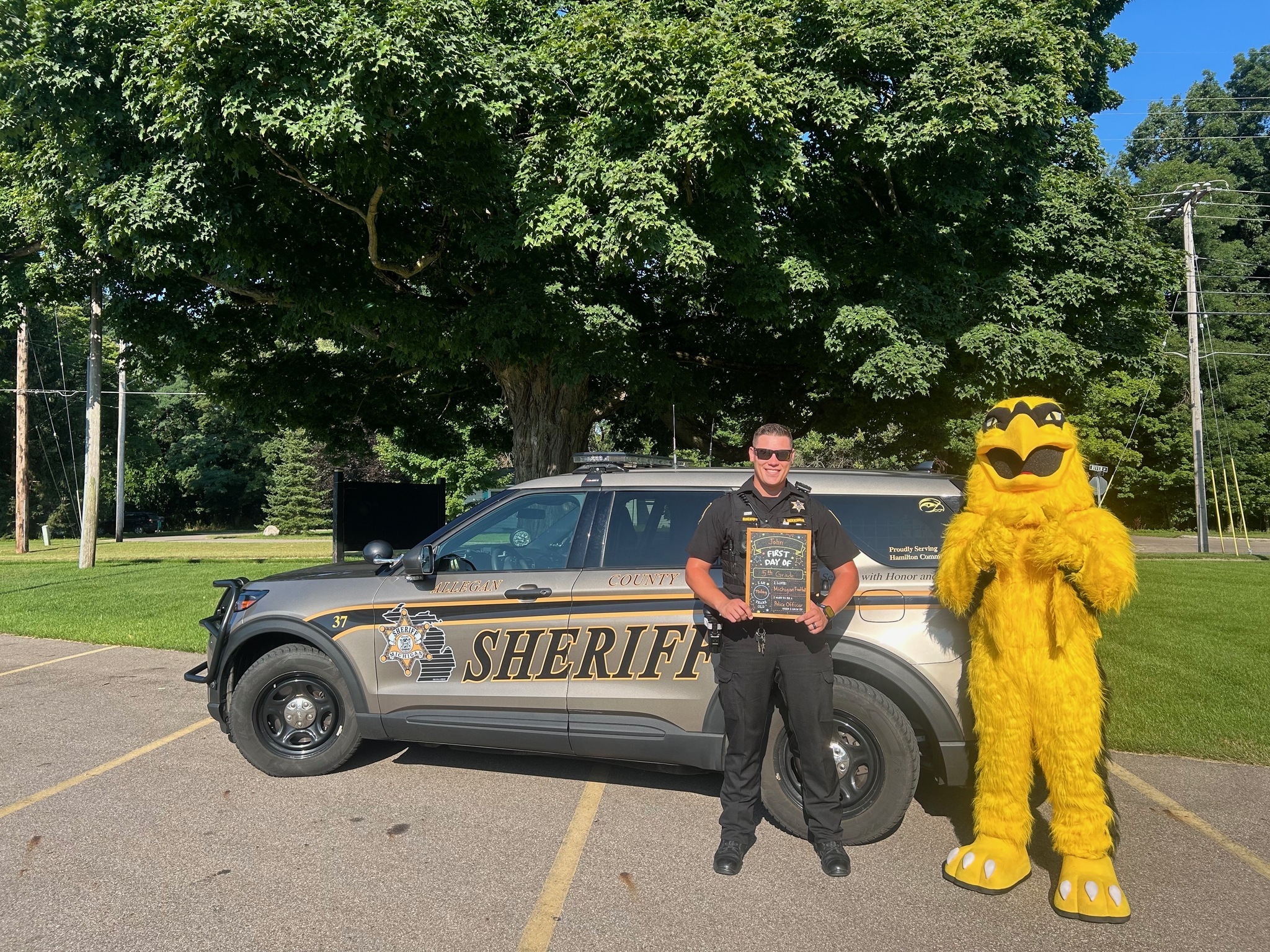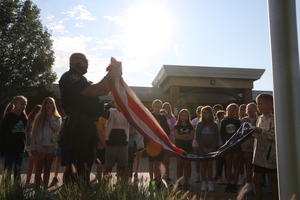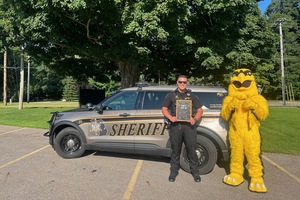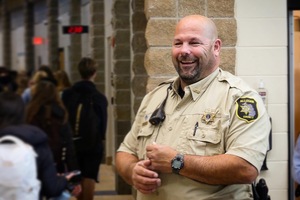Safety & Security

Welcome to the Hamilton Community Schools Safety & Security Website, which is overseen by School Resource Officer Deputy John Dekkinga of the Allegan County Sheriff's Department.
The Role of Students & Parents
School Bus Safety
Stop for School Buses
Many students rely on school buses to get them to and from school safely.
Did You Know: School buses are the most regulated vehicles on the road; they’re designed to be safer than passenger vehicles in preventing crashes and injuries; and in every state, stop-arm laws exist to protect children from other motorists.
If you are driving, remember these simple rules:
- Yellow flashing lights indicate the bus is preparing to stop to load or unload children. You should slow down and prepare to stop your vehicle.
- Red flashing lights and extended stop arms indicate the bus has stopped and children are getting on or off. You must stop your car and wait until the red lights stop flashing, the extended stop-arm is withdrawn, and the bus begins moving, before you can start driving again.
- Even when lights aren’t flashing, watch for children, particularly in the morning or mid-afternoon, around school arrival and dismissal times. Be alert as you back out of a driveway, or drive through a neighborhood, school zone or bus stop.
Parents - talk bus safety with your children:
Your child should arrive at the bus stop at least 5 minutes before the bus is scheduled to arrive. Teach them to play it SAFE:
- Stay at least ten feet — five giant steps — away from the curb.
- Always wait until the bus comes to a complete stop and the bus driver signals for you to board.
- Face forward after finding a seat on the bus.
- Exit the bus after it stops and look left-right-left for cars before crossing a street.
Bike Safety
Why Is Bike Safety So Important?
Bike riding is a lot of fun, but accidents happen. Every year, lots of kids need to see their doctor or go to the emergency room because of bike injuries.
Why Should Kids Wear a Bike Helmet?
Wearing a helmet that fits well every time you're on a bike helps protect your face, head, and brain if you fall. That's why it's so important to wear your bike helmet whenever you are on a bike.
Bike helmets are so important that the U.S. government has created safety rules for them. Your helmet should have a sticker that says it meets the rules set by the Consumer Product Safety Commission (CPSC). If your helmet doesn't have a CPSC sticker, ask your parent about getting you one that does.
Wear a bike helmet every time you ride, even if you're going for a short ride. And follow these rules:
- Make sure your bike helmet fits you well.
- Always wear your helmet the right way so it will protect you: Make sure it covers your forehead and don't let it tip back. Always fasten the straps.
- Don't wear a hat under your helmet.
- Take care of your helmet and don't throw it around. If it's damaged, it won't protect you as well when you need it.
- Get a new helmet if you fall while you're on your bike and hit your head.
- Put reflective stickers on your helmet so drivers can see you better.
What's the Right Bike for Me?
Riding a bike that is the right size for you helps to keep you safe. If you go to a bike store, ask the people who work there to help you get the right fit. In general, your feet should easily touch the ground as you sit on the seat and your legs shouldn’t be too bent when you pedal.
Making a safety checklist is important. Ask your parent for help:
- Make sure your seat, handlebars, and wheels fit tightly.
- Check and oil your chain regularly.
- Check your brakes to be sure they work well and aren't sticking.
- Check your tires to make sure they have enough air and the right amount of tire pressure.
What Should I Wear When I Ride My Bike?
- Wearing bright clothes and putting reflectors on your bike also can help you stay safe. It helps other people on the road see you. And if they see you, that means they're less likely to run into you.
- You'll also want to make sure that nothing will get caught in your bike chain, such as loose pant legs, backpack straps, or shoelaces.
- Wear the right shoes — sneakers — when you bike. Sandals, flip-flops, shoes with heels, and cleats won't help you grip the pedals. And never go riding barefoot!
- Riding gloves may help you grip the handlebars — and make you look like a professional!
- Don't use music devices that could distract you from noises around you, such as a car blowing its horn so you can get out of the way.
- Don’t text or use a cellphone while riding. You need to watch where you're going and look out for cars, people, and other bikes.
Where Is it Safe to Ride My Bike?
You need to check with your mom or dad about:
- where you're allowed to ride your bike
- how far you're allowed to go
- whether you should ride on the sidewalk or in the street. Kids younger than 10 years should ride on the sidewalk and avoid the street.
- common things that can get in the way like rocks, children or pets, and big puddles
- No matter where you ride, daytime riding is the safest. So try to avoid riding your bike once it starts getting dark.
- And always keep an eye out for cars and trucks. Even if you're just riding on the sidewalk, a car may pull out of its driveway into the path of your bike. When you cross a busy road, walk your bike across the street.
What Road Rules Should I Know?
If you're allowed to ride on the street, follow these road rules:
- Always ride with your hands on the handlebars.
- Always stop and check for traffic in both directions when leaving your driveway, an alley, or a curb.
- Cross at intersections. When you pull out between parked cars, drivers can't see you coming.
- Walk your bike across busy intersections using the crosswalk and following traffic signals.
- Ride on the right-hand side of the street, so you travel in the same direction as cars do. Never ride against traffic.
- Use bike lanes wherever you can.
- Don't ride too close to parked cars. Doors can open suddenly.
- Stop at all stop signs and obey traffic (red) lights just as cars do.
Ride single-file on the street with friends.
When passing other bikers or people on the street, always pass to their left side, and call out "On your left!" so they know that you are coming.
Understanding Deepfakes
Dear Parents/Guardians:
In today’s rapidly evolving digital landscape, a new challenge has emerged that is important for us to address as a school community: the rise of artificial intelligence-generated deepfakes. Deepfakes are videos or photos that have been altered using technology to make people appear to say or do things they never did. Creating deepfakes can be easier than most people think, presenting a growing challenge in distinguishing between what is real and what is not. As your partners in education and child development, we want to equip you with knowledge and tools to help you protect your children from this rapidly growing threat.
Awareness and Vigilance: It’s important to understand what deepfakes are and the potential risks they pose to help you spot them and keep your family safer online. Deepfakes can be used to create false representations of individuals, including students, potentially leading to misinformation and harm. Sometimes, people use them to create fake news or bully others by making it look like they’re doing or saying things that aren’t true or real.
Talk and Share: One of the best things you can do is talk with your kids about what they see on the internet. Ask them about the videos and photos they come across and if they think they are real or not. It’s not just about telling them what’s right or wrong; it’s about helping them think and decide for themselves.
Useful Tips and Help: We have some great tips and tools for you and your kids at OASSN.org. These include guidance on how to identify deepfakes, tips for safer internet usage, and where to report suspicious content. These resources are designed to empower you and your children to navigate the digital landscape with confidence and caution.
We understand that this is a complex and potentially concerning issue. By working togther and engaging in conversations, we can create a safer and more positive digital environment for our students and families.
Thank you for entrusting your children with us. If you have any questions, please feel free to email me directly. Go Hawkeyes!
Deputy Joe Knapp
Hamilton Community Schools SRO
Allegan County Sheriff's Department

School Safety/Security Stories
 Deputy Joe Knapp teaches Bentheim Elementary 4th graders about importance of the American Flag August 23, 2024
Deputy Joe Knapp teaches Bentheim Elementary 4th graders about importance of the American Flag August 23, 2024
 Get to know new School Resource Officer, Deputy John Dekkinga August 16, 2024
Get to know new School Resource Officer, Deputy John Dekkinga August 16, 2024
 Deputy Joe Knapp announces his retirement, new School Resource Officer named August 7, 2024
Deputy Joe Knapp announces his retirement, new School Resource Officer named August 7, 2024




